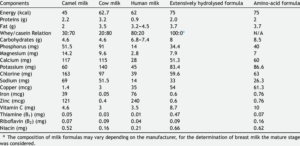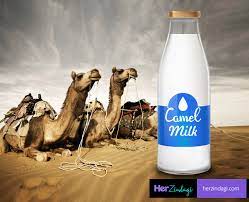UNVEILING THE IMPORTANCE AND BENEFITS OF CAMEL MILK
Karishma Choudhary and Vinod Kumar Palsaniya
M.V.Sc. (LPM), CVAS, NAVANIA, VALLABHNAGAR, UDAIPUR
In the vast expanse of arid landscapes, where the scorching sun dominates the horizon and water is scarce, thrives an extraordinary creature — the camel. Known as the “ship of the desert,” camels have been integral to the survival and livelihoods of civilizations in these harsh environments for millennia. Beyond their ability to endure extreme conditions, camels offer another precious gift: their milk. Renowned for its nutritional richness and therapeutic properties, camel milk stands as a testament to the resilience and adaptability of nature, providing numerous benefits to human health and well-being.
Composition of Camel Milk:
Protein makes up 3.1%, fat makes up 3.5%, lactose makes up 4.4%, ash makes up 0.79%, and total solids make up 11.9% of camel milk on average. The water content in camel milk is the most crucial component. The amount of solid matter overall is comparable to human milk.

Historical Significance:
The consumption of camel milk traces back centuries, deeply rooted in the cultural practices of nomadic and desert-dwelling communities across the Middle East, Africa, and Asia. Historically, camel milk served as a vital source of sustenance for these societies, offering hydration, nourishment, and medicinal value in regions where alternatives were scarce.
Nutritional Prowess:
Camel milk is a nutritional powerhouse, boasting a composition uniquely suited to meet human dietary needs. Rich in proteins, vitamins, and minerals, it provides a wholesome blend of essential nutrients vital for overall health. Compared to cow’s milk, camel milk contains higher levels of vitamin C, iron, and unsaturated fatty acids, making it a valuable addition to diverse diets, particularly for individuals with specific nutritional requirements or sensitivities.
Health Benefits:
The consumption of camel milk has been associated with a myriad of health benefits, ranging from improved immune function to enhanced digestion. Research indicates that camel milk possesses potent antimicrobial, anti-inflammatory, and immunomodulatory properties, making it effective in combating infections, allergies, and autoimmune disorders.
Furthermore, camel milk has garnered attention for its potential role in managing chronic conditions such as diabetes and cardiovascular disease. Studies suggest that its unique composition, including bioactive peptides and insulin-like proteins, may contribute to regulating blood sugar levels, reducing cholesterol, and promoting cardiovascular health.
Therapeutic Applications:
Traditional Iranian medicine (TIM) claims that camel milk has a composition more similar to human milk, high nutritional content, and beneficial effects. Several case reports, in vivo/in vitro research, and clinical trials evaluated the medicinal effects of camel milk. Six review studies on camel milk mentioned its potential applications in the treatment of rickets, autism, cirrhosis of the liver, hepatitis, rotavirus diarrhea, TB, diabetes, cancer, and autoimmune illnesses.
Beyond its nutritional value, camel milk has been utilized in traditional medicine systems for its therapeutic properties. In many cultures, it is revered for its ability to alleviate ailments ranging from gastrointestinal disorders to skin conditions. The immunoglobulins and lactoferrin present in camel milk are believed to confer therapeutic effects, making it a sought-after remedy for conditions such as lactose intolerance, autism spectrum disorders, and even cancer.
Sustainable Livelihoods:
In addition to its health benefits, the production and sale of camel milk offer a sustainable livelihood for communities in arid and semi-arid regions. Camel herding and milk production provide economic opportunities, especially for nomadic and pastoralist societies whose way of life revolves around these resilient animals. By harnessing the potential of camel milk, these communities not only ensure their sustenance but also contribute to the preservation of traditional knowledge and cultural heritage.
Environmental Resilience:
Camels epitomize adaptability and resilience in the face of environmental challenges. Thriving in harsh climates with minimal resources, they require far less water and forage compared to traditional dairy livestock, making them well-suited to arid environments. By promoting the sustainable utilization of camels and their milk, we can mitigate the environmental impact associated with conventional dairy farming practices while fostering resilience in vulnerable ecosystems.
Conclusion:
In a world where the quest for nutritional excellence and sustainable living is ever-present, camel milk emerges as a symbol of resilience, nourishment, and holistic well-being. Its rich nutritional profile, coupled with its therapeutic potential and cultural significance, underscores its importance as a valuable resource for humanity. As we strive to forge a healthier, more sustainable future, embracing the benefits of camel milk offers a compelling pathway toward promoting health, preserving biodiversity, and honoring the age-old bond between humans and the majestic camels of the desert.
References:
- Konuspayeva, G., Faye, B., & Loiseau, G. (2009). The composition of camel milk: a meta-analysis of the literature data. Journal of food composition and analysis, 22(2), 95-101.


